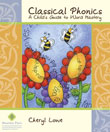Classical Phonics: A Child’s Guide to Word Mastery is based on the 1913 book, Word Mastery, by Florence Akin. Akin’s simple approach to teaching phonics was updated with more modern illustrations, reorganized, and slightly expanded. It is similar in concept to Noah Webster’s Reading Handbook from Christian Liberty Press.
It can be used to introduce letters or sounds, and it can be used to continue through all the phonograms and common sight words. This one book is used by both teacher and student. Very brief instruction is in small print at the foot of the page. Five pages of additional teaching suggestions at the back of the book should be read by the teacher before beginning.
Once past the introduction of individual letters and sounds, the rest of the pages consist of lists of words with occasional black-and-white illustrations. Words are presented most of the time in word families. For example, a column on page 37 has “u” at the top. Below, the first part of the column reads, “ut, c ut, n ut, b ut, r ut, h ut.” This vowel-consonant/word-family approach is used through the first six units.
Rules are kept to a minimum and are used to teach but not for the child to memorize. The expectation is that as children learn and practice each pattern, they will internalize it. Words such as “parachute, enough, laugh, anchor, though,” and “dough” are taught as words with unusual spellings rather than with rules. Prefixes, suffixes, plurals, and possessives are also taught.
The book is divided into ten units with an assessment at the end of each unit. Assessments are lists of words from the unit that children should now be able to read.
There are no sentences or stories in Classical Phonics, so you might want to supplement with other readers as you progress.
You can easily use Classical Phonics as your source for spelling words. While Classical Phonics can be used as a stand-alone resource for teaching phonics, you will need other resources for reading practice as well as for instruction in printing. That makes First Start Reading (also from Memoria Press) an excellent companion or precursor to Classical Phonics since FSR provides the missing practice and printing instruction. Once through FSR, it should be easy to use Classical Phonics to continue teaching the remaining phonograms, possibly supplementing with the SRA Phonics 2 workbook for written practice and review as suggested by the publisher. Classical Phonics should also work for those who need to teach phonics quickly to an older child.









